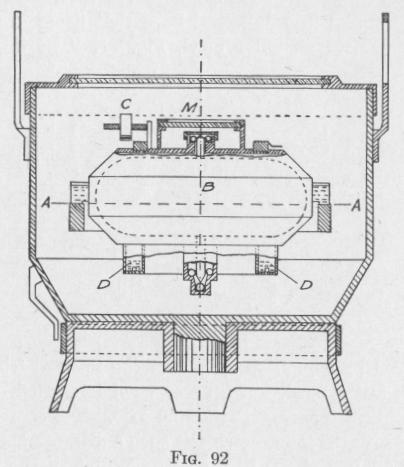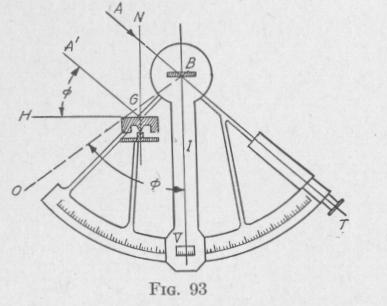118 THE GYROSCOPIC PENDULUM
only a small tilting of the spin-axis in the vertical plane of observation. A torque about the axis BB, further from the center of gravity, produces a precession of short period, as required for a quick succession of half-period observations.
The amplitude of oscillation of the spin-axle is damped by the friction of a mass of liquid moving back and forth in an annular trough D fastened to the gyro-casing concentric with the spin-axle.
Tilting of the spin-axle, due to the rotation of the earth, can be neutralized by a torque capable of producing an equal precession toward the east (Art. 41). The required precession is produced by the weight of a nut C that can be adjusted in position in azimuth and also in distance from the spin-axis. This nut must be either north or south of the spin-axle, depending on the direction of spin, and at a distance from the spin-axle depending upon the latitude. In setting the instrument for measuring the altitude of a celestial body, the instrument is turned till the gimbal axis nearer the center of gravity of the gyro and casing is in the vertical plane of the body under observation, the horizontal ring carrying the adjusting nut C is rotated till the nut is in the geographical meridian and on the proper side of the spin-axle, and the nut is moved horizontally to the scale position corresponding to the latitude of the place.
GYRO-HORIZONTALS AND GYRO-VERTICALS 119
75. The Bonneau-LePrieur-Derrien Gyro-Sextant. - This is a light instrument designed for the use of aviators. It consists of a sextant to which is attached a gyro-horizon. Without reference to a visible horizon, altitudes can be measured with it to a precision within about fifteen minutes of angle. Attached to the sextant frame is a case in which is a top G, Fig. 93, capable of rapid rotation. The top is provided with a row of blades about the periphery. It is set into rotation and maintained at a high speed by means of either a few strokes of a bicycle pump or by gas escaping from one of the little steel capsules called " sparklets " filled with liquefied carbon dioxide and which are sometimes used to aerate beverages. The upper surface of the top is a plane
mirror which maintains a
nearly horizontal position while the top is spinning rapidly about a vertical axis NG.
Pivoted to the center B
of the divided arc of the frame of the instrument is an index arm I which carries at one end a vernier scale V and at the other end a plane mirror B. The mirror is divided into
two parts, one part being silvered and the other part being transparent. The surface of the mirror is in the plane of the axis of the pivot and is perpendicular to the axis of the index arm. The axis of the telescope is perpendicular to and intersects the axis of the pivot. The divisions of the scale are reckoned from a zero 0 on a line through the pivot perpendicular to the axis of the telescope.
When the telescope is pointed to a star, light from the star traverses the transparent part of the index mirror and forms an image in the focal plane of the telescope eye-piece. Light from the star is also incident on the horizontal gyro-mirror G. The index arm can be turned so that light after reflection from the gyro-mirror and the index mirror will form another image superposed on the first.
Since A'G and A T are two parallel lines cut by GB, we have the angle
A'GB = GBT or 1.(A'GB) = A (GBT) = NGB

